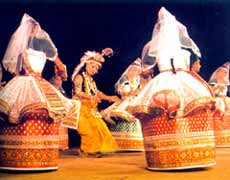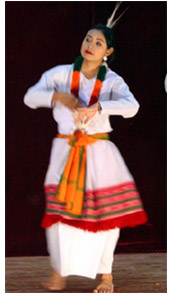|
|
|
Dance
Lai
- Haraoba
The Manipuris believe that this dance represents the concept
of the beginning of the world. There is a legend that in the beginning
there was only Guru Sidaba, the highest Lord, existing in the dark vacuum.
Once the brilliant hues of the rainbow shot into this dark space and the
beams of light motivated the Guru to witness the world with flora and
fauna. So he sent Atiya Guru along with a creature to create the world.
This creature spun a web-like frame work on which the human inhabitation
was to be initiated. Atiya Guru desired to solidify the framework. He
went again to Guru Sidaba. The Guru offered him some dirt from his navel
and also created nine men from his right side and seven women from his
left side to assist Atiya Guru. The dirt was to be applied to the framework
to solidify it. Atiya Guru along with the team of men and women sat down
to work. Their attempt was foiled twice by one Harba. Guru Sidaba then
sent the goddess of lightning to assist Atiya Guru. With her graceful
beauty and charm, the goddess could entice Harba away. The framework was
then solidified and declared fit for human habitation. On its completion,
the occasion was celebrated as Lai-Haraoba. Twelve main sequences, part
by part depict each process in the creation.
 Nongdai
Jagoi : Nongdai
Jagoi is the dance of commencing the split in the sky or the splitting
of the rainbow in the sky by Guru Sidaba. The hands are moved skywards
in trying to bring the two parts together. In Leitai Dance, the dancer
moves his waist in circular movements depicting the spreading of earth dirt on
the web-like framework. When the earth is completed and divided into
different divisions, the dance starts by moving hands from side to side.
Leitai Dance depicts the formation of the trace with the dirt from the
Guru's navel. The dance steps are done on tiptoes. Lai-Haraoba is performed
in worship of gods like Pakhangba, Thangjing etc. It has got three main
forms. The Kanglei Lai-Haraoba is celebrated at the palace. The Moirang
Lai-Haraoba is celebrated in the honour of Lord Thangjing and the Chakpa
Lai-Haraoba which is basically observed by Loi people. Lai Haraoba takes
place in Manipuri month of Kalen (April/May). It continues for a week.
There are certain days of the month which are considered auspicious and
the festival is celebrated on these dates like 1, 2, 3, 5 and 8. The deities
are represented by a pair of bamboo tubes, wooden or brass mark with cloths
placed below and above, pieces of wood or iron or a coin etc. Nongdai
Jagoi : Nongdai
Jagoi is the dance of commencing the split in the sky or the splitting
of the rainbow in the sky by Guru Sidaba. The hands are moved skywards
in trying to bring the two parts together. In Leitai Dance, the dancer
moves his waist in circular movements depicting the spreading of earth dirt on
the web-like framework. When the earth is completed and divided into
different divisions, the dance starts by moving hands from side to side.
Leitai Dance depicts the formation of the trace with the dirt from the
Guru's navel. The dance steps are done on tiptoes. Lai-Haraoba is performed
in worship of gods like Pakhangba, Thangjing etc. It has got three main
forms. The Kanglei Lai-Haraoba is celebrated at the palace. The Moirang
Lai-Haraoba is celebrated in the honour of Lord Thangjing and the Chakpa
Lai-Haraoba which is basically observed by Loi people. Lai Haraoba takes
place in Manipuri month of Kalen (April/May). It continues for a week.
There are certain days of the month which are considered auspicious and
the festival is celebrated on these dates like 1, 2, 3, 5 and 8. The deities
are represented by a pair of bamboo tubes, wooden or brass mark with cloths
placed below and above, pieces of wood or iron or a coin etc.
The dance is divided into seven sections. First section
is the Lai Ikouba. This consist s
in calling the Lai out of water. The Maibi sits before water from which
Lai is called up, chanting incantations and ringing a hand-bell. It is
called Laimang Phamba (sitting before the Lai). Second is the Laibou Jagoi
which is a dance with antiphonal singing, representing the life cycle
of Lai. Third is the Panthaibi Jagoi which is a dance depicting the romantic
tale of Nangpok Ningthou and Panthoibi. The episode is always danced in
Naga costumes. Some expressions of jhuming cultivation are also expressed
during this dance. It may be of Tangkhul origin. Fourth is the Lairen
Mathek. It is a communal dance in which the circular pattern representing
the python is danced. s
in calling the Lai out of water. The Maibi sits before water from which
Lai is called up, chanting incantations and ringing a hand-bell. It is
called Laimang Phamba (sitting before the Lai). Second is the Laibou Jagoi
which is a dance with antiphonal singing, representing the life cycle
of Lai. Third is the Panthaibi Jagoi which is a dance depicting the romantic
tale of Nangpok Ningthou and Panthoibi. The episode is always danced in
Naga costumes. Some expressions of jhuming cultivation are also expressed
during this dance. It may be of Tangkhul origin. Fourth is the Lairen
Mathek. It is a communal dance in which the circular pattern representing
the python is danced.
It is limited to Kamglei Haraoba and is related
to the python manifestation of Pakhangba. Basically it is related to the
royal clan, the Ningthouja. Fifth is the Ougri Hangel. It is also a communal
dance designed to bring wealth and prosperity. Sixth is the Thoubal Chongba.
It is called the dancing by moon light in circle. It has seasonal importance.
In the month of March/April after 'Yaosang' (Holi), this dance is performed
in the Mandapas of Temples or in the open air. Boys, girls and grown up
people take part in its performance. The Thoubal Chongba offers a chance
to express the element of excitement and activities in dance form. In
villages and towns the organisers arrange a beautiful illumination by
fitting the tube lights on bamboo posts around a sufficient area which
is centrally located public places. In the moon-lit night the dances go
on till late at night. Boys and girls dance together in a group forming
a long chain. The dancers may join and leave at different intervals at
their own convenience. Seventh is the Nongkarel at the end of the festival.
The Lai-Haraoba is the combination of religious recitations, traditional
music and dance, traditional social values and ancient cultural aspects.
|

